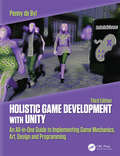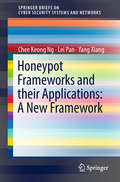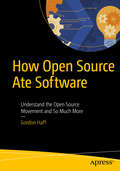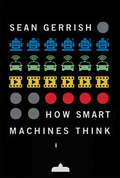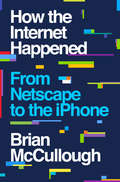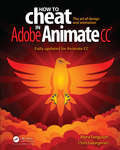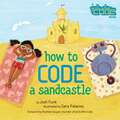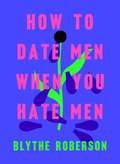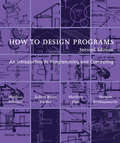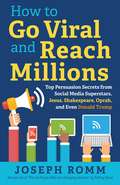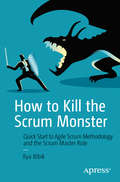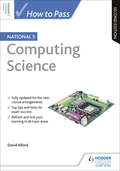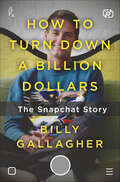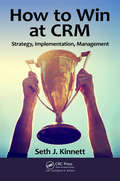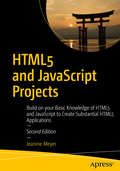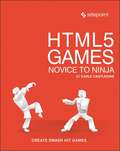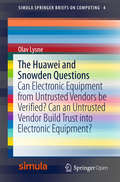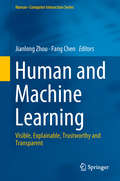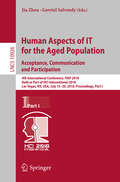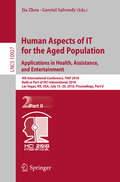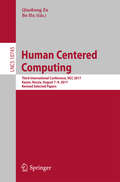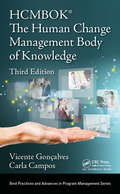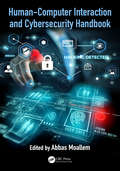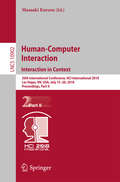- Table View
- List View
Holistic Game Development with Unity 3e: An All-in-One Guide to Implementing Game Mechanics, Art, Design and Programming
by Penny de BylMaster game design and digital art principles simultaneously with this all-in-one guide to creating games in the cutting-edge game engine Unity. Reworked for C# and Unity 2018 & 2019, and bursting with images and tutorials, Penny de Byl’s Holistic Game Development with Unity will help the reader gain the multidisciplinary skills needed to succeed in the independent game industry. Holistic Game Development with Unity includes new coverage on Augmented Reality, Networking, and Virtual Reality such as the Oculus Rift. Supplementary material, including instructional videos, discussion forums and art assets are provided in the companion website located at www.holistic3d.com. Learn to combine the beauty of art and the functionality of programming in de Byl’s third edition for Unity game development. Key features: Art and programming in Unity, the only one-stop shop for individual developers and small teams looking to tackle both tasks. Proven step-by-step tutorials show you how to design and structure an entire game in Unity with art assets. Revised to cover the Unity game engine versions 2018 and 2019. New coverage of Nav Meshes, Augmented Reality, Mobile Builds and Mecanim. An introduction to essential two- and three-dimensional mathematical and physics concepts. A portfolio of royalty free reusable game mechanics. Revamped and expanded accompanying website, www.holistic3d.com, features project source code, instructional videos, art assets, author blog, and discussion forums. Additional challenge questions and lesson plans are available online for an enhanced learning experience.
Honeypot Frameworks and Their Applications: A New Framework (SpringerBriefs on Cyber Security Systems and Networks)
by Yang Xiang Lei Pan Chee Keong NgThis book presents the latest research on honeypots and their applications. After introducing readers to the basic concepts of honeypots and common types, it reviews various honeypot frameworks such as web-server-based, client-based, shadow and artificially intelligent honeypots. In addition, it offers extensive information on the contribution of honeypots in some of the most popular malware research area such as DDoS, Worm, APT, forensics and Bot attacks. The book subsequently tackles the issue of honeypot countermeasures, shows many of the tricks often used by hackers to discover honeypots, and proposes a counter-countermeasure to help conceal them. It then puts forward a new framework that integrates various novel concepts, and which can feasibly be used for the detection of potential ransomware and bitcoin. As such, the book provides non-experts with a concise guide to honeypots, and will also benefit practitioners working on security systems.
How Open Source Ate Software: Understand The Open Source Movement And So Much More
by Gordon HaffLearn how free software became open source and how you can sell open source software. This book provides a historical context of how open source has thoroughly transformed how we write software, how we cooperate, how we communicate, how we organize, and, ultimately, how we think about business values.You’ll look at project and community examples including Linux, BSD, Apache, and Kubernetes, understand the open source development model, and how open source has influenced approaches more broadly, even proprietary software, such as open betas. You'll also examine the flipside, the "Second Machine Age," and the challenges of open source-based business models.Today, open source serves as shorthand for much broader trends and behaviors. It’s not just about a free (in all senses of the word) alternative to commercial software. It increasingly is the new commercial software. How Open Source Ate Software reveals how open source has much in common, and is often closely allied, with many other trends in business and society. You'll see how it enables projects that go beyond any individual company. That makes open source not just a story about software, but a story about almost everything.What You'll LearnUnderstand open source opportunities and challengesSell software if you’re giving it awayApply open source principles more broadly to openorg, devops, etc.Review which organizational incentives you can implement Who This Book Is ForAnyone who has an interest in what is happening in open source and the open source community, and anyone who is contemplating making a business that involves open source.
How Smart Machines Think (The\mit Press Ser.)
by Sean GerrishEverything you've always wanted to know about self-driving cars, Netflix recommendations, IBM's Watson, and video game-playing computer programs.The future is here: Self-driving cars are on the streets, an algorithm gives you movie and TV recommendations, IBM's Watson triumphed on Jeopardy over puny human brains, computer programs can be trained to play Atari games. But how do all these things work? In this book, Sean Gerrish offers an engaging and accessible overview of the breakthroughs in artificial intelligence and machine learning that have made today's machines so smart.Gerrish outlines some of the key ideas that enable intelligent machines to perceive and interact with the world. He describes the software architecture that allows self-driving cars to stay on the road and to navigate crowded urban environments; the million-dollar Netflix competition for a better recommendation engine (which had an unexpected ending); and how programmers trained computers to perform certain behaviors by offering them treats, as if they were training a dog. He explains how artificial neural networks enable computers to perceive the world—and to play Atari video games better than humans. He explains Watson's famous victory on Jeopardy, and he looks at how computers play games, describing AlphaGo and Deep Blue, which beat reigning world champions at the strategy games of Go and chess. Computers have not yet mastered everything, however; Gerrish outlines the difficulties in creating intelligent agents that can successfully play video games like StarCraft that have evaded solution—at least for now. Gerrish weaves the stories behind these breakthroughs into the narrative, introducing readers to many of the researchers involved, and keeping technical details to a minimum. Science and technology buffs will find this book an essential guide to a future in which machines can outsmart people.
How the Internet Happened: From Netscape To The Iphone
by Brian McCulloughTech-guru Brian McCullough delivers a rollicking history of the internet, why it exploded, and how it changed everything. The internet was never intended for you, opines Brian McCullough in this lively narrative of an era that utterly transformed everything we thought we knew about technology. In How the Internet Happened, he chronicles the whole fascinating story for the first time, beginning in a dusty Illinois basement in 1993, when a group of college kids set off a once-in-an-epoch revolution with what would become the first “dotcom.” Depicting the lives of now-famous innovators like Netscape’s Marc Andreessen and Facebook’s Mark Zuckerberg, McCullough also reveals surprising quirks and unknown tales as he tracks both the technology and the culture around the internet’s rise. Cinematic in detail and unprecedented in scope, the result both enlightens and informs as it draws back the curtain on the new rhythm of disruption and innovation the internet fostered, and helps to redefine an era that changed every part of our lives.
How to Cheat in Adobe Animate CC (How To Cheat)
by Myra Ferguson Chris GeorgenesWould you rather take months to learn every tool, every feature, and every concept in Adobe Animate or start right now making your own creations with just a few steps? Myra Ferguson is teaming up with Chris Georgenes to help you create great animation, bring objects to life with cool motion effects, and enhance your productivity in Animate CC! How to Cheat in Adobe Animate CC is a goldmine of artistic inspiration, time-saving practical tips, and step-by-step walkthroughs. Let your sasquatch sunbathe, your coyote howl, and your lint spider see the light of day. With real-world projects and project source files, you can follow along and try for yourself. This book includes all NEW content and cheats for Animate CC, such as making cinemagraphs, creating a double exposure effect, speeding up the process of making real life doodles, simulating a bokeh effect, converting your documents to HTML5, and more. Key Features • Glimpse into the workflow of digital media and animation experts and apply practical techniques and tips to your own projects with source files, examples, and tutorials. • Learn a myriad of tricks based on real-life working methods to help you work faster and more efficiently with new features in Adobe Animate CC and the Creative Cloud. • Work from the problem to the solution to gain the best possible results from Animate.
How to Code a Sandcastle
by Josh FunkFrom the computer science nonprofit Girls Who Code comes this lively and funny story introducing kids to computer coding concepts.All summer, Pearl has been trying to build the perfect sandcastle, but out-of-control Frisbees and mischievous puppies keep getting in the way! Pearl and her robot friend Pascal have one last chance, and this time, they&’re going to use code to get the job done. Using fundamental computer coding concepts like sequences and loops, Pearl and Pascal are able to break down their sandcastle problem into small, manageable steps. If they can create working code, this could turn out to be the best beach day ever! With renowned computer science nonprofit Girls Who Code, Josh Funk and Sara Palacios use humor, relatable situations, and bright artwork to introduce kids to the fun of coding.
How to Date Men When You Hate Men
by Blythe RobersonFrom New Yorker and Onion writer and comedian Blythe Roberson, How to Date Men When You Hate Men is a comedy philosophy book aimed at interrogating what it means to date men within the trappings of modern society. Blythe Roberson’s sharp observational humor is met by her open-hearted willingness to revel in the ugliest warts and shimmering highs of choosing to live our lives amongst other humans. She collects her crushes like ill cared-for pets, skewers her own suspect decisions, and assures readers that any date you can mess up, she can top tenfold. And really, was that date even a date in the first place?With sections like Real Interviews With Men About Whether Or Not It Was A Date; Good Flirts That Work; Bad Flirts That Do Not Work; and Definitive Proof That Tom Hanks Is The Villain Of You’ve Got Mail, How to Date Men When You Hate Men is a one stop shop for dating advice when you love men but don't like them."With biting wit, Roberson explores the dynamics of heterosexual dating in the age of #MeToo"— The New York Times
How to Design Programs, second edition: An Introduction to Programming and Computing (The\mit Press Ser.)
by Matthias Felleisen Robert Bruce Findler Matthew Flatt Shriram KrishnamurthiA completely revised edition, offering new design recipes for interactive programs and support for images as plain values, testing, event-driven programming, and even distributed programming.This introduction to programming places computer science at the core of a liberal arts education. Unlike other introductory books, it focuses on the program design process, presenting program design guidelines that show the reader how to analyze a problem statement, how to formulate concise goals, how to make up examples, how to develop an outline of the solution, how to finish the program, and how to test it. Because learning to design programs is about the study of principles and the acquisition of transferable skills, the text does not use an off-the-shelf industrial language but presents a tailor-made teaching language. For the same reason, it offers DrRacket, a programming environment for novices that supports playful, feedback-oriented learning. The environment grows with readers as they master the material in the book until it supports a full-fledged language for the whole spectrum of programming tasks.This second edition has been completely revised. While the book continues to teach a systematic approach to program design, the second edition introduces different design recipes for interactive programs with graphical interfaces and batch programs. It also enriches its design recipes for functions with numerous new hints. Finally, the teaching languages and their IDE now come with support for images as plain values, testing, event-driven programming, and even distributed programming.
How to Go Viral and Reach Millions: Top Persuasion Secrets from Social Media Superstars, Jesus, Shakespeare, Oprah, and Even Donald Trump
by Joseph RommHow to Go Viral and Reach Millions is the first book to reveal all the latest secrets for consistently generating viral online content-words, images, or videos that are seen and shared by hundreds of thousands and eventually even millions of people, something Romm and his colleagues in three different organizations achieve routinely.
How to Kill the Scrum Monster: Quick Start to Agile Scrum Methodology and the Scrum Master Role
by Ilya BibikImplement Scrum or improve how Scrum works in your team or organization using this concise, sharp, and programmatic book. You will quickly learn what you need to know without getting confused with unnecessary details.What You'll LearnBecome familiar with Agile concepts and understand the path from Waterfall to the Agile ManifestoUnderstand the most commonly used Agile methodology—Scrum—and how it relates to eXtreme Programming and Kanban as well as to Lean principlesIdentify the challenges of the Scrum Master role and understand what this role is all aboutKnow the stages of Scrum team developmentEmbrace and solve conflicts in a Scrum teamWho This Book Is ForAnyone looking for a simple way to understand Scrum methodology
How to Make a Robot
by Gordon McCombLearn the basics of modern robotics while building your own intelligent robot from scratch! You'll use inexpensive household materials to make the base for your robot, then add motors, power, wheels, and electronics. But wait, it gets better: your creation is actually five robots in one! -- build your bot in stages, and add the features you want. Vary the functions to create a robot that's uniquely yours. Mix and match features to make your own custom robot: Flexible Motorized Base -- a playpen for all kinds of programming experiments; Obstacle Detector -- whiskers detect when your robot has bumped into things; Object Avoider -- ultrasonic sound lets your robot see what's in front of it; Infrared Remote Control -- command your robot from your easy chair; Line Follower -- use optics to navigate your bot; have races with other robot builders! You will learn how switches, ultrasonics, infrared detectors, and optical sensors work. Install an Arduino microcontroller board and program your robot to avoid obstacles, provide feedback with lights and sound, and follow a tracking line. In this book you will combine multiple disciplines -- electronics, programming, and engineering -- to successfully build a multifunctional robot. You'll discover how to: construct a motorized base; set up an Arduino to function as the brainuse "whisker" switches to detect physical contact; avoid obstacles with ultrasonic sensors; teach your robot to judge distances; use a universal remote to control your robot; install and program a servo motor; respond to input with LEDs, buzzers, and tones; mount line-following sensors under your robot. And more. Everything is explained with lots and lots of full-color line drawings. No prior experience is necessary. You'll have fun while you learn a ton!
How to Pass National 5 Computing Science: Second Edition
by David AlfordExam Board: SQALevel: National 5Subject: Computing ScienceFirst Teaching: August 2017First Exam: May 2018Get your best grade with the SQA endorsed guide to National 5 Computing Science.Fully updated to account for the removal of Unit Assessments and the changes to the National 5 exam, this book contains all the advice and support you need to revise successfully. It combines an overview of the course syllabus with advice from a top expert on how to improve exam performance, so you have the best chance of success.- Refresh your knowledge with complete course notes- Prepare for the exam with top tips and hints on revision technique- Get your best grade with advice on how to gain those vital extra marks
How to Turn Down a Billion Dollars: The Snapchat Story
by Billy Gallagher"In the grand tradition of Ben Mezrich's The Accidental Billionaires (2009)... an engaging look into a fascinating subculture of millions." —Booklist"Breezy...How to Turn Down a Billion Dollars ably if uncritically chronicles the short history of a young company catering to young users, with a young chief executive, and reveals, intentionally or not, the limitations that come with that combination." —Wall Street JournalThe improbable and exhilarating story of the rise of Snapchat from a frat boy fantasy to a multi-billion dollar internet unicorn that has dramatically changed the way we communicate.In 2013 Evan Spiegel, the brash CEO of the social network Snapchat, and his co-founder Bobby Murphy stunned the press when they walked away from a three-billion-dollar offer from Facebook: how could an app teenagers use to text dirty photos dream of a higher valuation? Was this hubris, or genius? In How to Turn Down a Billion Dollars, tech journalist Billy Gallagher takes us inside the rise of one of Silicon Valley's hottest start-ups. Snapchat developed from a simple wish for disappearing pictures as Stanford junior Reggie Brown nursed regrets about photos he had sent. After an epic feud between best friends, Brown lost his stake in the company, while Spiegel has gone on to make a name for himself as a visionary—if ruthless—CEO worth billions, linked to celebrities like Taylor Swift and his wife, Miranda Kerr. A fellow Stanford undergrad and fraternity brother of the company’s founding trio, Gallagher has covered Snapchat from the start. He brings unique access to a company Bloomberg Business called “a cipher in the Silicon Valley technology community.” Gallagher offers insight into challenges Snapchat faces as it transitions from a playful app to one of the tech industry’s preeminent public companies. In the tradition of great business narratives, How to Turn Down a Billion Dollars offers the definitive account of a company whose goal is no less than to remake the future of entertainment.
How to Win at CRM: Strategy, Implementation, Management
by Seth KinnettThis book provides clarity and guidance on effective strategy, implementation and management of CRM. It explores both the conceptual and cultural context of CRM initiatives along with the particulars of CRM system implementation and management. In order to provide this clarity, it surveyed the existing academic publications surrounding CRM, sales force automation, and related topics within information systems literature. The book supplements this research with insights from CRM experts to provide a robust picture of the CRM landscape and how to improve it no matter what role you play within your organization. This book is for everyone who wants to achieve CRM success.
HTML5 and JavaScript Projects
by Jeanine MeyerBuild on your basic knowledge of HTML5 and JavaScript to create substantial HTML5 applications. Through the many interesting projects you can create in this book, you'll develop HTML5 skills for future projects, and extend the core skills you may have learned with its companion book, The Essential Guide to HTML5. HTML5 and JavaScript Projects is fully updated as a second edition and covers important programming techniques and HTML, CSS, and JavaScript features to help you build projects with images, animation, video, audio and line drawings. You'll learn how to build games, quizzes and other interactive projects; incorporate the use of the Google Maps API and localStorage; and address the challenges of Responsive Design and Accessibility.Each project starts out with a description of the example's operation, often with full-color illustrations. You'll then review the HTML5 and JavaScript concepts that relate to the project followed by a step-by-step explanation of the programming used. Tables are used to show the relationship of functions and provide comments for each line of code so that you can easily apply the techniques to your own HTML5 projects.What You'll Learn Enhance your HTML5 and JavaScript programming skills.Poduce applications combining Canvas drawings, photos, and videos Incorporate Google Maps and geolocation into your projects Build applications requiring persistent data, storing the information locally or on a database on the server Who This Book Is ForDevelopers who have some knowledge of programming and want to build more substantial applications by combining basic features and combining JavaScript with other technologies.
HTML5 Games: Novice to Ninja
by Earle Castledine<p>This book will teach you how to create awesome video games. Games from scratch. Games that run cross-platform, in web browsers, and on phones. Games filled with dynamic sound and music. Games overflowing with impressive visual effects. Fun games. <p>More importantly, this book will teach you how to think about making games. You'll learn to analyze and dissect games; to understand what it is that makes great games great. By the end of the journey you'll have all the knowledge and tools needed to produce engaging, polished products that people will love to play. <p>What's inside? <p> <li>Learn the basics: game loops and input <li>Draw graphics on the screen using Canvas <li>Add amazing sound effects and music using the Web Audio API <li>Develop several fun games: a platformer, a shoot em up, a dungeon crawler, and a physics-based game <li>Create your own JavaScript game library <li>Jazz up your game up with "juice": screen shakes, particle effects, and more</li> </p>
The Huawei and Snowden Questions
by Olav LysneThis open access book answers two central questions: firstly, is it at all possible to verify electronic equipment procured from untrusted vendors? Secondly, can I build trust into my products in such a way that I support verification by untrusting customers? In separate chapters the book takes readers through the state of the art in fields of computer science that can shed light on these questions. In a concluding chapter it discusses realistic ways forward. In discussions on cyber security, there is a tacit assumption that the manufacturer of equipment will collaborate with the user of the equipment to stop third-party wrongdoers. The Snowden files and recent deliberations on the use of Chinese equipment in the critical infrastructures of western countries have changed this. The discourse in both cases revolves around what malevolent manufacturers can do to harm their own customers, and the importance of the matter is on par with questions of national security.This book is of great interest to ICT and security professionals who need a clear understanding of the two questions posed in the subtitle, and to decision-makers in industry, national bodies and nation states.
Human and Machine Learning: Visible, Explainable, Trustworthy and Transparent (Human–Computer Interaction Series)
by Jianlong Zhou Fang ChenWith an evolutionary advancement of Machine Learning (ML) algorithms, a rapid increase of data volumes and a significant improvement of computation powers, machine learning becomes hot in different applications. However, because of the nature of “black-box” in ML methods, ML still needs to be interpreted to link human and machine learning for transparency and user acceptance of delivered solutions. This edited book addresses such links from the perspectives of visualisation, explanation, trustworthiness and transparency. The book establishes the link between human and machine learning by exploring transparency in machine learning, visual explanation of ML processes, algorithmic explanation of ML models, human cognitive responses in ML-based decision making, human evaluation of machine learning and domain knowledge in transparent ML applications. This is the first book of its kind to systematically understand the current active research activities and outcomes related to human and machine learning. The book will not only inspire researchers to passionately develop new algorithms incorporating human for human-centred ML algorithms, resulting in the overall advancement of ML, but also help ML practitioners proactively use ML outputs for informative and trustworthy decision making. This book is intended for researchers and practitioners involved with machine learning and its applications. The book will especially benefit researchers in areas like artificial intelligence, decision support systems and human-computer interaction.
Human Aspects of IT for the Aged Population. Acceptance, Communication and Participation: 4th International Conference, ITAP 2018, Held as Part of HCI International 2018, Las Vegas, NV, USA, July 15–20, 2018, Proceedings, Part I (Lecture Notes in Computer Science #10926)
by Jia Zhou Gavriel SalvendyThis book constitutes the proceedings of the 4th International Conference onHuman Aspects of IT for the Aged Population, ITAP 2018, held as part of the 20th International Conference, HCI International 2018, which took place in Las Vegas, Nevada, in July 2018.The total of 1171 papers and 160 posters included in the 30 HCII 2018 proceedings volumes was carefully reviewed and selected from 4346 submissions. ITAP 2018 includes a total of 84 papers. They were organized in topical sections as follows: Part I: aging and technology acceptance; aging and interaction; intergenerational communication and social participation. Part II: health care technologies and services for the elderly; intelligent environments for aging; and games and entertainment for the elderly.
Human Aspects of IT for the Aged Population. Applications in Health, Assistance, and Entertainment: 4th International Conference, ITAP 2018, Held as Part of HCI International 2018, Las Vegas, NV, USA, July 15–20, 2018, Proceedings, Part II (Lecture Notes in Computer Science #10927)
by Jia Zhou Gavriel SalvendyThis book constitutes the proceedings of the 4th International Conference onHuman Aspects of IT for the Aged Population, ITAP 2018, held as part of the 20th International Conference, HCI International 2018, which took place in Las Vegas, Nevada, in July 2018. The total of 1171 papers and 160 posters included in the 30 HCII 2018 proceedings volumes was carefully reviewed and selected from 4346 submissions. ITAP 2018 includes a total of 84 papers. They were organized in topical sections as follows: Part I: aging and technology acceptance; aging and interaction; intergenerational communication and social participation. Part II: health care technologies and services for the elderly; intelligent environments for aging; and games and entertainment for the elderly.
Human Centered Computing
by Qiaohong Zu Bo HuThis book constitutes revised selected papers from the thoroughly refereed proceedings of the Third International Human Centered Computing Conference, HCC 2017, that consolidated and further develops the successful ICPCA/SWS conferences on Pervasive Computing and the Networked World, and which was held in Kazan, Russia, in August 2017. The 48 full and 20 short papers presented in this book together with 2 invited keynotes were carefully reviewed and selected from numerous submissions. This proceedings present recent advances in human machine interfaces, wireless and mobile network technologies, and data analytics, which make computer services truly human-centric.
The Human Change Management Body of Knowledge (Best Practices in Portfolio, Program, and Project Management)
by Vicente Goncalves Carla Campos"I am happy to recommend this work. I believe in the principles presented in it and identify with its context. Due to the lack of knowledge on the subject in the market, it is a topic that must be made known. The book should be in the library of all project and change managers."— Paul Dinsmore, PMI Fellow "Every manager should integrate HCMBOK® practices into their project management methodology in order to fully develop their work. This book addresses a simple and practical way that the critical component in organizational change management can be applied to projects of all kinds: the human factor."— Bruno Machado, Director, Project Management Office, Grupo Anima Educação "We live in a time of change, speed, and an avalanche of information. It is still very difficult for most companies to change their organizational culture efficiently. This book makes us reflect upon the crucial element in any change, and which most managers do not place in the foreground—the people." — Joyce Meyer, CEO, iDigo "In today's constantly changing world, the Project Manager must have sensitivity to how people react to change. Knowing a method that provides a structured way to take care of the human aspect is a key factor in the success of any project! HCMBOK® offers a simple and practical approach to managing change, which can be easily incorporated into the project management routine, providing amazing results."— Pedro Augusto Cardoso da Silva, Engineering Director, METRÔRIO This reference starts by presenting the concept of change management, its players, strategies, and applicable models. In the second part, the book covers the set of good practices, methodology, and tools known as the HCMBOK®— Human Change Management Body of Knowledge. The third part introduces the concept of the Change Management Office (CMO) and its relation to the strategic planning of an organization. The book concludes with the competencies essential for a change manager, an approach to agile methodologies, and a model for managing cultural change.
Human-Computer Interaction and Cybersecurity Handbook (Human Factors and Ergonomics)
by Abbas Moallem<P><P>Recipient of the SJSU San Jose State University Annual Author & Artist Awards 2019 <P><P>Recipient of the SJSU San Jose State University Annual Author & Artist Awards 2018 <P><P>Cybersecurity, or information technology security, focuses on protecting computers and data from criminal behavior. The understanding of human performance, capability, and behavior is one of the main areas that experts in cybersecurity focus on, both from a human–computer interaction point of view, and that of human factors. This handbook is a unique source of information from the human factors perspective that covers all topics related to the discipline. It includes new areas such as smart networking and devices, and will be a source of information for IT specialists, as well as other disciplines such as psychology, behavioral science, software engineering, and security management. <P><P>Features <li>Covers all areas of human–computer interaction and human factors in cybersecurity <li>Includes information for IT specialists, who often desire more knowledge about the human side of cybersecurity <li>Provides a reference for other disciplines such as psychology, behavioral science, software engineering, and security management <li>Offers a source of information for cybersecurity practitioners in government agencies and private enterprises <li>Presents new areas such as smart networking and devices
Human-Computer Interaction. Interaction in Context: 20th International Conference, HCI International 2018, Las Vegas, NV, USA, July 15–20, 2018, Proceedings, Part II (Lecture Notes in Computer Science #10902)
by Masaaki KurosuThe 3 volume-set LNCS 10901, 10902 + 10903 constitutes the refereed proceedings of the 20th International Conference on Human-Computer Interaction, HCI 2018, which took place in Las Vegas, Nevada, in July 2018. The total of 1171 papers and 160 posters included in the 30 HCII 2018 proceedings volumes was carefully reviewed and selected from 4346 submissions. HCI 2018 includes a total of 145 papers; they were organized in topical sections named: Part I: HCI theories, methods and tools; perception and psychological issues in HCI; emotion and attention recognition; security, privacy and ethics in HCI. Part II: HCI in medicine; HCI for health and wellbeing; HCI in cultural heritage; HCI in complex environments; mobile and wearable HCI. Part III: input techniques and devices; speech-based interfaces and chatbots; gesture, motion and eye-tracking based interaction; games and gamification.
